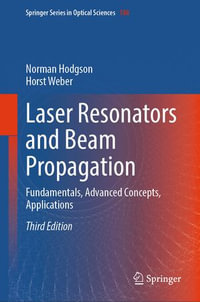
eBOOK
Orthogonal Polarization in Lasers
Physical Phenomena and Engineering Applications
By: Shulian Zhang, Wolfgang Holzapfel
eBook | 22 April 2016 | Edition Number 1
At a Glance
464 Pages
eBook
$219.99
or 4 interest-free payments of $55.00 with
orInstant Digital Delivery to your Booktopia Reader App
Read on
Lasers generally emit radiation, which is either simply linearly polarized or unpolarized and stochastically polarized. Contrary to these common lasers, all orthogonally polarized lasers simultaneously emit radiation in two linear polarization states, both exactly orthogonally oriented to each other. Due to this orthogonality, both polarized components in the beam are independent of each other to a high degree and the studies presented in this book make clear that this feature can give a strong advantage in certain laser applications, for instance in high-precision measurements.
Orthogonal Polarization in Lasers: Physical Phenomena and Engineering Applications summarizes the basics and advanced research results of orthogonally polarized lasers, birefringence laser cavities, and their applications. The authors include a number of figures, experimental designs, and measurement curves to enable the reader to not only learn the basic principles and technologies but also to understand many applications in modern engineering and to start their own R&D projects.
The book covers polarization effects, which are of fundamental importance across various disciplines of science and technology.
- Includes a number of figures, experimental designs, and measurement curves to help readers learn the basic principles and start their own R&D projects.
- Discusses many types of relevant lasers (helium/neon lasers, ND:YAG lasers, semiconductor lasers, laser diodes).
- Written by multiply-published authors in the subject area.
- Contains material useful for metrology applications.
This book is intended for use by researchers, postgraduates, and engineers working in laser science, optics, and measurement and testing, while senior undergraduate students working in optical and laser science can use the book for advanced understanding in their field.
Read on
by Zhou Bingkun
Foreword xix
by Konrad Herrmann
Preface xxi
Introduction xxv
Part One FUNDAMENTALS OF LASERS AND BEAM POLARIZATIONS
1 Rigorous Introduction to Lasers and Beam Polarizations 3
1.1 The Basic Amplifier/Cavity Configuration 3
1.2 Optical Waves of a Laser 4
1.3 Cavity Closed-Loop and Laser Threshold 8
1.4 Survey of Techniques for Generating and Converting Laser Polarization States 16
References 24
2 Basic Physical Effects Inside Lasers 25
2.1 Interaction between Light and Particles 25
2.2 Line Shape Function and the Line Broadening Mechanism 30
2.3 Gain Coefficient of Light in an Active Medium 38
2.4 Saturation of Gain in the Laser Active Medium 40
2.5 Threshold Condition, Gain for Stationary Operation, and Lasing Bandwidth 44
2.6 Optical Cavities and Laser Modes 46
2.7 Laser Mode Competition 50
2.8 Mode Push/Pull and Locking Effects 54
2.9 Power Tuning Properties of Lasers 55
References 59
3 Specific Laser Technologies Applicable for Orthogonally Polarized Beam Generation 61
3.1 Background 61
3.2 He-Ne lasers 62
3.3 Carbon Dioxide (CO2) Laser and Its Polarization State 68
3.4 Optically Pumped Nd:YAG Lasers (1.06 ?m) 69
3.5 Semiconductor Lasers 72
3.6 Fiber Lasers 76
3.7 Conclusions on Relevant Orthogonally Polarized Laser Technologies 78
References 80
Part Two GENERATION OF ORTHOGONAL LASER POLARIZATIONS
4 Zeeman Dual-Frequency Lasers and Multifrequency Ring Lasers - Orthogonally Polarized Lasers in Tradition 83
4.1 Introduction 83
4.2 Zeeman Dual-Frequency Lasers 84
4.3 Multifrequency Ring Laser 88
References 96
5 Matrix Theory of Anisotropic Laser Cavities - A Further Approach to Orthogonally Polarized Dual-Frequency Lasers 99
5.1 Background 99
5.2 Polarization-Dependent Properties of Optical Materials 100
5.3 Introduction to the Jones Formalism 101
5.4 Mathematical Description of Polarized Light by the Jones Vectors 102
5.5 Transfer Matrixes of Retarders, Rotators, and Polarizers 103
5.6 Serial Connections of Anisotropic Elements and the Jones Theorem 105
5.7 Connection of Different Retardations within the Same Anisotropic Element 107
5.8 Calculation of Eigenpolarizations and Eigenfrequencies of Passive Anisotropic Cavities 107
5.9 Conclusions 111
References 111
6 Orthogonal Polarization and Frequency Splitting in Birefringent Laser Cavities 113
6.1 Laser Frequency Splitting Due to Intracavity Birefringence 113
6.2 Laser Frequency Splitting Caused by Intracavity Quartz Crystals 117
6.3 Laser Frequency Splitting Caused by Intracavity Electro-optic Crystals 125
6.4 Induced Stress Birefringence and Laser Frequency Splitting 129
6.5 Frequency Splitting in Semiconductor Lasers 133
6.6 Frequency Splitting in Fiber Lasers 136
6.7 Observation and Readout of Frequency Splitting 137
6.8 Final Remark on Methods Used to Obtain Small and Also Larger Frequency Differences 143
References 143
7 Design of Orthogonally Polarized Lasers 145
7.1 Background 145
7.2 Quartz Birefringence He-Ne Laser 147
7.3 Stress-Induced Birefringence He-Ne Laser 150
7.4 Equidistant Frequency Split Ultrashort He-Ne Laser 153
7.5 Zeeman Birefringence Dual-Frequency He-Ne Laser 154
7.6 He-Ne Laser with Two Intracavity Birefringence Elements 158
7.7 Orthogonally Polarized Lasers with a Superposition Layer Birefringence Film 161
7.8 Laser Diode Pumped Birefringent Nd:YAG Laser with Tunable Frequency Difference 163
7.9 Orthogonally Polarized Lasers with Electrically Controllable Frequency Differences 169
References 170
Part Three NONLINEAR BEHAVIOR OF ORTHOGONALLY POLARIZED LASERS
8 Competition and Flipping Phenomena in Orthogonally Polarized Lasers 175
8.1 Intensity Tuning, Mode Competition, and Frequency Difference Tuning in Dual-Frequency Lasers 176
8.2 Properties of Intensity Tuning and Frequency Difference Tuning in Birefringent Zeeman Lasers 184
8.3 Polarization Properties Caused by Optical Activity of an Intracavity Quartz Crystal 191
8.4 Effect of Optical Activity in the Frequency Difference 198
8.5 Polarization Flipping and Optical Hysteresis in Birefringent Lasers 201
References 209
9 Optical Feedback Effects in Orthogonally Polarized Lasers 211
9.1 General Concept of Laser Feedback 212
9.2 Optical Feedback for Birefringent He-Ne Lasers 216
9.3 Optical Feedback of Birefringence Zeeman Lasers 235
9.4 Optical Feedback with an Orthogonally Polarized External Cavity 241
9.5 Narrow Feedback Fringes of Birefringent Dual-Frequency Lasers 248
9.6 Optical Feedback of a Microchip Nd:YAG Laser with Birefringence 256
9.7 Conclusions on the Feedback in Orthogonally Polarized Lasers 266
References 269
10 Semi-classical Theory of Orthogonally Polarized Lasers 273
10.1 Modeling of Orthogonally Polarized Lasers 273
10.2 Theoretical Analysis of Orthogonally Polarized Lasers 288
10.3 Analysis of Optical Feedback Phenomena in Birefringent Lasers 299
References 307
Part Four APPLICATIONS OF ORTHOGONALLY POLARIZED LASERS
11 Introduction and Background of Applications 311
11.1 Survey of the Application Potential 311
11.2 What Is the Particularity of OPDF Laser Measurements? 313
References 315
12 Measurements of Optical Anisotropies by Orthogonally Polarized Lasers 317
12.1 Phase Retardation Measurement of Wave Plates by Laser Frequency Splitting 318
12.2 Phase Retardation Measurements of Optical Components Based on Laser Feedback and Polarization Flipping 333
12.3 Intracavity Transmission Ellipsometry for Optically Anisotropic Components 340
References 343
13 Displacement Measurement by Orthogonally Polarized Lasers 345
13.1 Background and Basic Considerations 345
13.2 Zeeman OPDF Laser Interferometer 347
13.3 Displacement Measurement Based on Cavity Tuning of Orthogonal Polarized Lasers - OPMC Displacement Transducers 350
13.4 Displacement Measurement Based on Feedback of Orthogonally Polarized Lasers 364
13.5 Displacement Measurement Based on Feedback of the BZ-Laser 369
13.6 Displacement Measurement Based on Orthogonal Polarized Feedback of Nd:YAG Lasers 373
13.7 Microchip Nd:YAG Laser Interferometers with Quasi-Common-Path Feedback 376
References 382
14 Force and Pressure Measurement by Means of Photoelastic Nd:YAG Lasers 385
14.1 Principle and Experimental Setup of Force and Pressure Measurement 386
14.2 Force Measurement: Experimental Results 392
14.3 Pressure Measurement: Experimental Results 398
14.4 Advanced Studies in Force to Frequency Conversion 400
14.5 Prospects of Laser-Based Force Measurements 403
References 404
15 Measurements via Translation/Rotation of Intracavity Quartz Crystals 407
15.1 Displacement Measurement by Means of an Intracavity Quartz Crystal Wedge 407
15.2 Measurement of Earth's Gravity by Means of an Intracavity Quartz Crystal Wedge 409
15.3 Vibration Measurement by Means of an Intracavity Quartz Crystal Wedge 410
15.4 Measuring Rotation Angles by Means of an Intracavity Quartz Crystal Plate 412
References 414
16 Combined Magnetometer/Rate Gyro Transducers by Four-Frequency Ring Lasers 415
16.1 Principle of the Frequency Splitting Ring Laser Weak Magnetic Field Transducer 415
16.2 Experimental Arrangement 418
16.3 Experimental Results and Discussions 419
16.4 Conclusions 420
References 420
17 Further Applications of Orthogonally Polarized Lasers 421
17.1 Tunable Signal Generation 421
17.2 Polarized Lasers in Material Processing 422
References 423
18 Conclusions of Part Four 425
18.1 Phase Retardation Measurement Applications 425
18.2 Displacement Sensing Applications 426
18.3 Force, Pressure, and Acceleration Measurement Applications 426
Index 429
ISBN: 9781118346525
ISBN-10: 1118346521
Published: 22nd April 2016
Format: ePUB
Language: English
Number of Pages: 464
Audience: Professional and Scholarly
Publisher: Wiley
Country of Publication: SG
Edition Number: 1























